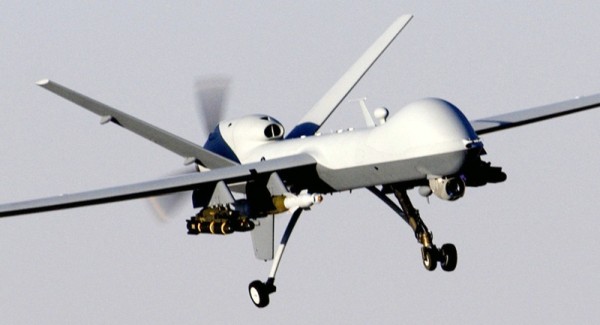 Russia has started flying drone aircraft on surveillance missions in Syria, U.S. officials said on Monday, in what appeared to be Moscow’s first military air operations there since staging a rapid buildup at a Syrian air base.
Russia has started flying drone aircraft on surveillance missions in Syria, U.S. officials said on Monday, in what appeared to be Moscow’s first military air operations there since staging a rapid buildup at a Syrian air base.
The beginning of Russian drone flights underscored the risks of U.S.-led coalition planes and Russian aircraft operating within Syria’s limited airspace, without agreeing on coordination or objectives in Syria’s civil war.
The former Cold War foes have a common adversary in Islamic State militants in Syria. But Washington opposes Moscow’s support for Syrian President Bashar al-Assad, seeing him as a driving force in the four-and-a-half year-long civil war.
The Pentagon declined comment at a news briefing when asked about the Reuters report on Russian drones, saying it could not discuss intelligence matters. But it said the U.S. Department of Defense was “keenly aware” of what was happening on the ground in Syria.
The White House acknowledged that Moscow’s intentions were unclear and that the prospect of deepening Russian military backing for Assad was troubling.
“We’ve made clear both in public and in private that doubling down on supporting Assad is a losing bet,” said White House spokesman Josh Earnest.
One U.S. official, speaking on condition of anonymity, said the number of fixed-wing, piloted Russian aircraft stationed at the air base near Latakia, an Assad stronghold, had also grown dramatically in recent days.
That included Russia’s positioning of a dozen “Fencer” advanced-attack aircraft and a dozen “Frogfoot” jets, used for close air support. Those were in addition to Russia’s first deployment of fighter jets last week.
U.S. Secretary of State John Kerry said over the weekend the United States welcomed Russia’s involvement in tackling Islamic State militants in Syria. But he said a worsening refugee crisis highlighted the need to find a compromise that could also lead to political change in the country.
Syria’s civil war has killed an estimated 250,000 people, and many continue to flee their homes, with 4 million refugees and another 7.6 million displaced inside the country.
Russian President Vladimir Putin has pledged to continue military support for Assad, assistance that Russia says is in line with international law.
It was also unclear whether Moscow might eventually target opposition fighters that the United States supports in Syria, seeing them as equal threats to Assad as Islamic State fighters.
U.S. and Russian defense chiefs agreed on Friday to explore ways to avoid accidental interactions, also known as “deconfliction” in military parlance. But those discussions were described as only at their inception.
It was unclear whether the U.S.-Russian talks might gain added urgency, now that Moscow has started drone flights.
Russia’s drone operations appeared to be staged out of the air base near Latakia, officials said.
Two U.S. officials, speaking on condition of anonymity, said it was not immediately clear how many Russian drone aircraft were operating or the scope of their missions.
At the State Department, spokesman John Kirby acknowledged concerns over the kind of Russian hardware being sent to Syria, saying it added to questions about whether Moscow’s aim was mostly to battle Islamic State or to “prop up the Assad regime.”
Meanwhile, Israel and Russia agreed to coordinate military actions over Syria in order to avoid accidentally trading fire. Israeli Prime Minister Benjamin Netanyahu said after talks in Moscow with Putin that they had “agreed on a mechanism to prevent such misunderstandings.”
We at Ya Libnan encourage and welcome an open exchange of ideas on this story’s topic, but we kindly ask all participants to follow our guidelines for respecting community standards. Personal attacks, inappropriate language, and off-topic comments may be removed, and comment privileges revoked .
REUTERS
Leave a Reply
You must be logged in to post a comment.